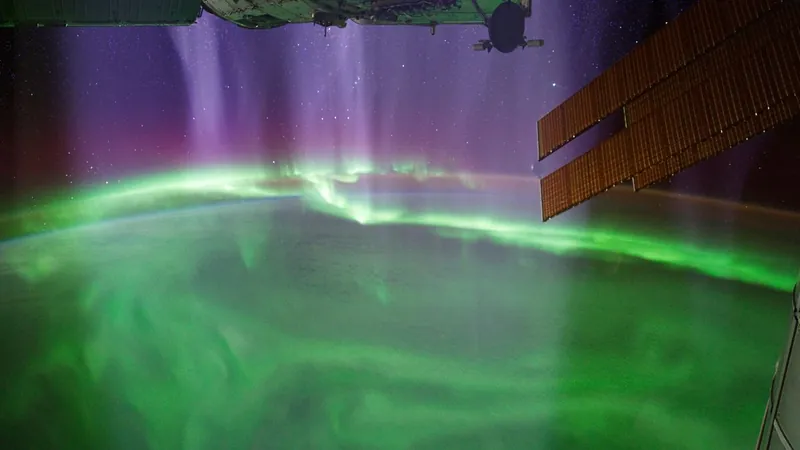
Mysterious 'Chirping Waves' Discovered Far from Earth: A New Threat to Space Travel?
2025-01-23
Author: Chun
Introduction
In a surprising revelation for scientists, enigmatic chirping waves resembling a bird's morning song have been detected thousands of miles away from Earth, raising alarms about potential risks for future space endeavors. Dubbed "chorus waves," these perturbations in Earth's electromagnetic field could accelerate particles to deadly speeds, posing significant challenges for spacecraft and astronauts venturing beyond our planet.
Chorus Waves: A New Discovery
Traditionally, chorus waves have been observed in proximity to Earth and other celestial bodies since the 1960s, leading researchers to believe that their influence was limited to nearby regions. However, a groundbreaking study from a team of scientists has unveiled the presence of these waves at a jaw-dropping distance of 100,000 miles (approximately 165,000 kilometers) away from Earth—three times farther than previously documented. The researchers shared their compelling findings on January 22, published in the prestigious journal *Nature*.
Understanding Chorus Waves
Chorus waves, also known as whistler-mode chorus waves, are short-lived bursts of energy that resonate across Earth's magnetosphere, the protective magnetic field surrounding our planet. Their existence was first noted by World War I radio operators who inadvertently picked them up while listening for enemy communications. Over the decades, these waves have been recorded by various radio receivers and NASA's Van Allen Probes, which detected their activity emanating from Earth's radiation belts. Moreover, chorus waves have been observed surrounding numerous planets, including Mercury, Jupiter, Saturn, Uranus, and Neptune—all possessing global magnetic fields—as well as Mars and Venus, even without magnetospheres.
The Mystery of Their Origins
The scientific community remains divided regarding the origins of these chorus waves. The prevailing theory attributes their formation to a phenomenon known as plasma instability. Electrons, ejected by solar activity, become trapped along the magnetic field lines of dipolar structures, like magnets or planetary magnetic fields. Under normal conditions, these particles travel in a spiraled, orderly pattern. However, disruptions in this structure can lead to the sudden generation of chorus waves, permitting electrons to gain tremendous speeds, nearing the speed of light.
Significance of Recent Findings
Intriguingly, the recent discovery of chorus waves at a considerable distance was made using NASA's Magnetospheric Multiscale satellites. These observations uncovered the waves arising from a relatively flat portion of Earth's magnetosphere, hinting that their production may stem from a shift in frequency across the field rather than the expected pole-to-pole traveling method.
Future Research and Implications
To further unravel the mystery of these newfound waves, researchers advocate for improved monitoring systems that track incoming plasma bursts from the sun and their interactions with Earth's magnetosphere. This could provide crucial insights needed to protect future satellites, astronauts, and deep space missions—especially in light of ambitious plans for Mars exploration and beyond.
Conclusion
What does this mean for the future of space travel? Scientists urge for immediate attention and innovative solutions to safeguard humanity’s quests beyond Earth before it's too late! Will we finally decode the secrets of these deadly choruses, or will they turn into a hitch in our space ambitions? Stay tuned for more updates on this thrilling cosmic mystery!



 Brasil (PT)
Brasil (PT)
 Canada (EN)
Canada (EN)
 Chile (ES)
Chile (ES)
 Česko (CS)
Česko (CS)
 대한민국 (KO)
대한민국 (KO)
 España (ES)
España (ES)
 France (FR)
France (FR)
 Hong Kong (EN)
Hong Kong (EN)
 Italia (IT)
Italia (IT)
 日本 (JA)
日本 (JA)
 Magyarország (HU)
Magyarország (HU)
 Norge (NO)
Norge (NO)
 Polska (PL)
Polska (PL)
 Schweiz (DE)
Schweiz (DE)
 Singapore (EN)
Singapore (EN)
 Sverige (SV)
Sverige (SV)
 Suomi (FI)
Suomi (FI)
 Türkiye (TR)
Türkiye (TR)
 الإمارات العربية المتحدة (AR)
الإمارات العربية المتحدة (AR)